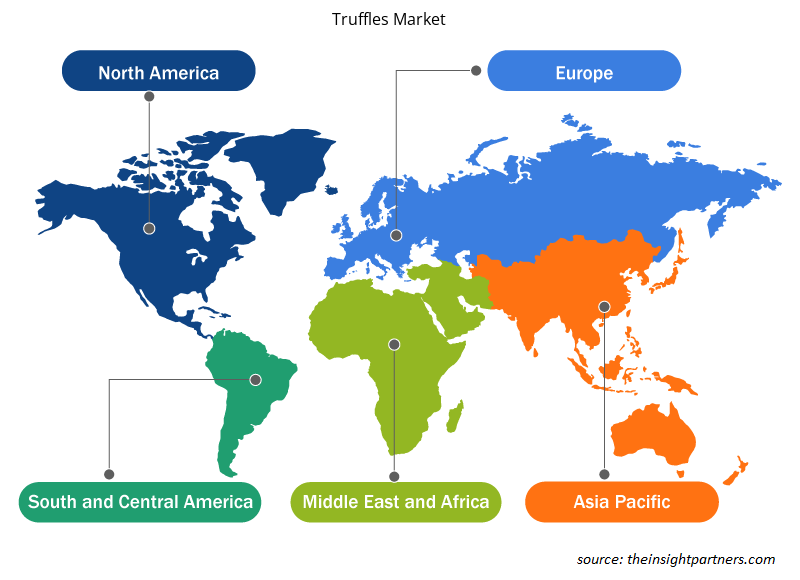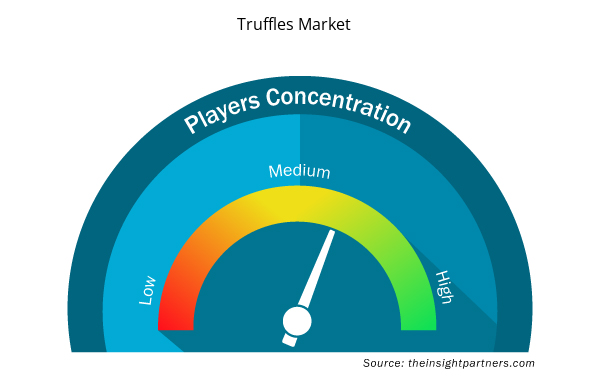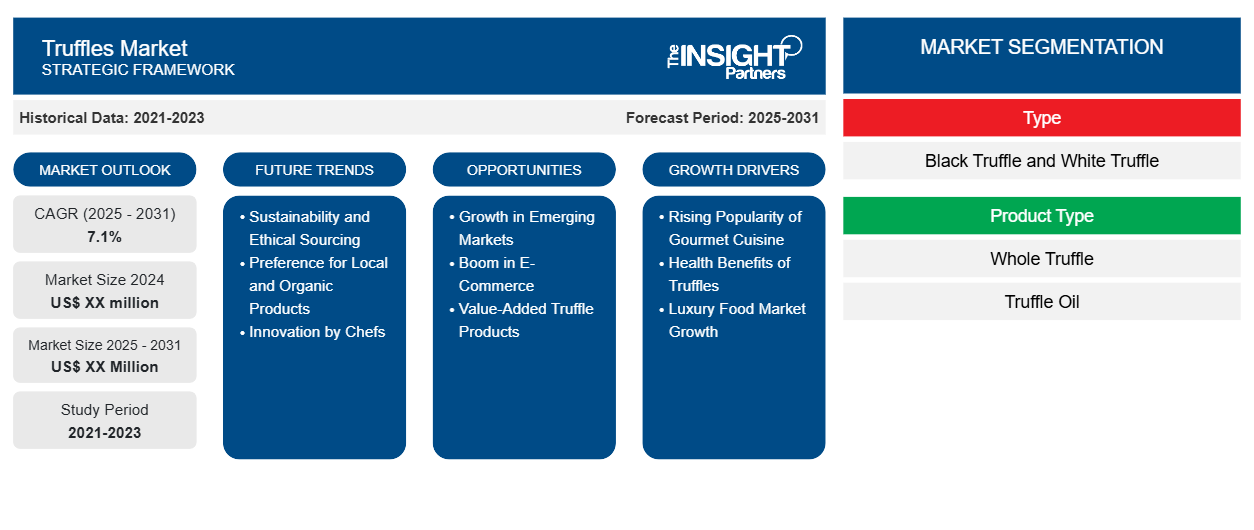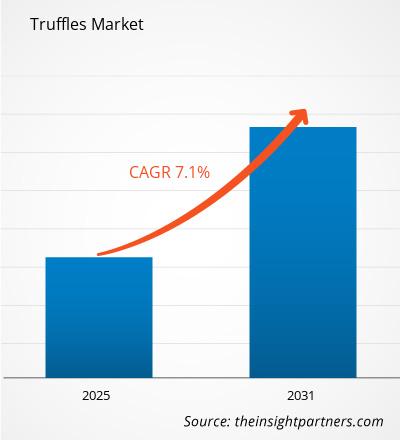Se espera que el mercado de trufas registre una CAGR del 7,1 % entre 2024 y 2031, con un tamaño de mercado que se expandirá de US$ XX millones en 2024 a US$ XX millones en 2031.
El informe está segmentado por tipo (trufa negra y trufa blanca). El informe está segmentado a su vez por tipo de producto (trufa entera, aceite de trufa y otros). El informe está segmentado por categoría (orgánica y convencional). El informe presenta además un análisis basado en el usuario final (servicio de alimentación y venta minorista de alimentos). El alcance del informe cubre cinco regiones: América del Norte, Europa, Asia Pacífico, Oriente Medio y África, y América del Sur y Central y los países clave de cada región. El análisis global se desglosa aún más a nivel regional y por países principales. El informe ofrece el valor en USD para el análisis y los segmentos anteriores.
Propósito del Informe
El informe Truffles Market de The Insight Partners tiene como objetivo describir el panorama actual y el crecimiento futuro, los principales factores impulsores, los desafíos y las oportunidades. Esto proporcionará información a diversas partes interesadas del negocio, como:
- Proveedores/fabricantes de tecnología: Para comprender la dinámica cambiante del mercado y conocer las oportunidades potenciales de crecimiento, lo que les permitirá tomar decisiones estratégicas informadas.
- Inversionistas: Realizar un análisis exhaustivo de tendencias sobre la tasa de crecimiento del mercado, las proyecciones financieras del mercado y las oportunidades que existen en toda la cadena de valor.
- Órganos reguladores: Regular las políticas y vigilar las actividades del mercado con el objetivo de minimizar los abusos, preservar la confianza de los inversores y defender la integridad y la estabilidad del mercado.
Segmentación del mercado de trufas
Tipo
- Trufa negra y trufa blanca
Tipo de producto
- Trufa entera
- Aceite de trufa
Categoría
- Orgánico y convencional
Geografía
- América del norte
- Europa
- Asia-Pacífico
- América del Sur y Central
- Oriente Medio y África
Personalice este informe según sus necesidades
Obtendrá personalización en cualquier informe, sin cargo, incluidas partes de este informe o análisis a nivel de país, paquete de datos de Excel, así como también grandes ofertas y descuentos para empresas emergentes y universidades.
- Obtenga las principales tendencias clave del mercado de este informe.Esta muestra GRATUITA incluirá análisis de datos, desde tendencias del mercado hasta estimaciones y pronósticos.
Factores impulsores del crecimiento del mercado de las trufas
- Creciente popularidad de la cocina gourmet: la cocina gourmet está aumentando rápidamente en popularidad, lo que impulsa el creciente mercado de la trufa. Los chefs, así como los entusiastas de la comida, recurren a las delicias gastronómicas para crear una composición gourmet y, con ello, los ingredientes de alta calidad se convierten en su máxima prioridad para darles sabores únicos, una tendencia que generalmente no se asocia solo con la alta cocina, sino que también atrae principalmente a los cocineros caseros, lo que hace que haya una gran apreciación y demanda de trufas.
- Beneficios de las trufas para la salud: Contrariamente a la creencia popular, la mayor conciencia sobre los efectos de las trufas para la salud está alimentando el interés por su uso culinario. Las trufas son ricas en antioxidantes y nutrientes, lo que las convierte en un complemento lujoso y nutritivo para diversos platos. Los consumidores conscientes están empezando a optar por ingredientes indulgentes que también pueden ser buenos para la dieta.
- Crecimiento del mercado de alimentos de lujo: el aumento del gasto en el mercado de alimentos de lujo es lo que determina la tendencia actual de las trufas. Dado que el consumidor estará dispuesto a desembolsar el dinero que tanto le costó ganar para gastarlo en productos de primera calidad, esto incluirá ingredientes gourmet como las trufas, cuyos precios están por las nubes. Esto sugiere que se está dando un mayor impulso cultural hacia la experiencia culinaria de alta calidad y poco común, lo que aumenta aún más el tamaño del mercado.
Tendencias futuras del mercado de trufas
- Sostenibilidad y abastecimiento ético: la creciente preocupación por el impacto ambiental que tienen las elecciones alimentarias hace que el abastecimiento sea cada vez más importante para el mercado de la trufa. Los productores asumen prácticas de recolección éticas, ya que los clientes son cada vez más conscientes del impacto ambiental de sus elecciones alimentarias. Esto no solo protege los ecosistemas, sino que también crea un sello de reputación para la marca. De hecho, todo, toda la creciente conciencia de los consumidores sobre el origen de los ingredientes gourmet atrae a una clientela objetivo con conciencia ecológica.eco-aware target clientele.
- Preferencia por productos locales y orgánicos: el mercado de la trufa muestra un gran interés por los productos locales y orgánicos. Los consumidores prefieren ingredientes frescos y de alta calidad con historias de origen abiertas. Esto respalda el concepto de incluir a los agricultores locales y crear una relación entre los consumidores, los productores y las trufas de maneras que inspiren y desarrollen la cultura alimentaria asociada a las trufas.
- Innovación de los chefs: Los chefs siguen siendo los maestros de la innovación en el uso de las trufas. Sus aplicaciones se han extendido a una amplia gama de platos que van desde lo salado a lo dulce, pasando por aceites, salsas y postres. Esto haría que las trufas fueran más atractivas y desafiaría la creatividad de los hogares.
Oportunidades de mercado para las trufas
- Crecimiento en mercados emergentes: El mercado de la trufa es un importante mercado para el crecimiento en los mercados emergentes. Con las tendencias en constante cambio en las cocinas globales, cada vez más países se centran en los ingredientes gourmet, un área que los mercados en crecimiento o los países gastronómicos consideran la más prometedora. El potencial de crecimiento de las trufas ofrece espacio para que los productores penetren más en nuevas bases de consumidores y aumenten significativamente la conciencia y el aprecio por lo que tradicionalmente se ha conocido o se conoce simplemente como trufa.
- Auge del comercio electrónico: el auge del comercio electrónico está fomentando la oportunidad de comercio basado en trufas. El comercio en línea permite a una empresa llegar directamente a los consumidores, simplificando así los canales de distribución. Esto hace que los productos de trufa de primera calidad sean más accesibles para los consumidores, ampliando así aún más el mercado tanto para las marcas establecidas como para los pequeños productores.
- Productos de trufa con valor añadido: Los productos de trufa con valor añadido son ahora una amplia perspectiva en el mercado. Los productores pueden desarrollar aceites, salsas o incluso aperitivos con infusión de trufa, aumentando el atractivo de una base de clientes diversa y ampliando las carteras de productos para los vendedores. Esto simplemente atraería a diferentes gustos de los consumidores y, por lo tanto, presentaría una mayor variedad de trufas en la cocina diaria y las experiencias gourmet.
Perspectivas regionales del mercado de trufas
Los analistas de Insight Partners han explicado detalladamente las tendencias y los factores regionales que influyen en el mercado de trufas durante el período de pronóstico. Esta sección también analiza los segmentos y la geografía del mercado de trufas en América del Norte, Europa, Asia Pacífico, Oriente Medio y África, y América del Sur y Central.

- Obtenga los datos regionales específicos para el mercado de trufas
Alcance del informe sobre el mercado de trufas
| Atributo del informe | Detalles |
|---|---|
| Tamaño del mercado en 2024 | XX millones de dólares estadounidenses |
| Tamaño del mercado en 2031 | US$ XX millones |
| Tasa de crecimiento anual compuesta (CAGR) global (2025-2031) | 7,1% |
| Datos históricos | 2021-2023 |
| Período de pronóstico | 2025-2031 |
| Segmentos cubiertos | Por tipo
|
| Regiones y países cubiertos | América del norte
|
| Líderes del mercado y perfiles de empresas clave |
|
Densidad de actores del mercado de trufas: comprensión de su impacto en la dinámica empresarial
El mercado de las trufas está creciendo rápidamente, impulsado por la creciente demanda de los usuarios finales debido a factores como la evolución de las preferencias de los consumidores, los avances tecnológicos y una mayor conciencia de los beneficios del producto. A medida que aumenta la demanda, las empresas amplían sus ofertas, innovan para satisfacer las necesidades de los consumidores y aprovechan las tendencias emergentes, lo que impulsa aún más el crecimiento del mercado.
La densidad de actores del mercado se refiere a la distribución de las empresas o firmas que operan dentro de un mercado o industria en particular. Indica cuántos competidores (actores del mercado) están presentes en un espacio de mercado determinado en relación con su tamaño o valor total de mercado.
Las principales empresas que operan en el mercado de la trufa son:
- Tartufi de Gazzarrini
- La casa plantin
- La trufa del Ventoux
- TRUFAS SABATINAS
- La Compañía de la Trufa y el Vino
Descargo de responsabilidad : Las empresas enumeradas anteriormente no están clasificadas en ningún orden particular.

- Obtenga una descripción general de los principales actores clave del mercado de trufas
Puntos de venta clave
- Cobertura integral: el informe cubre exhaustivamente el análisis de productos, servicios, tipos y usuarios finales del mercado de trufas, proporcionando un panorama holístico.
- Análisis de expertos: el informe se compila sobre la base de un profundo conocimiento de expertos y analistas de la industria.
- Información actualizada: El informe asegura relevancia comercial debido a su cobertura de información reciente y tendencias de datos.
- Opciones de personalización: este informe se puede personalizar para satisfacer los requisitos específicos del cliente y adaptarse adecuadamente a las estrategias comerciales.
Por lo tanto, el informe de investigación sobre el mercado de trufas puede ayudar a abrir camino para descifrar y comprender el escenario de la industria y las perspectivas de crecimiento. Si bien puede haber algunas preocupaciones válidas, los beneficios generales de este informe tienden a superar las desventajas.
- Análisis histórico (2 años), año base, pronóstico (7 años) con CAGR
- Análisis PEST y FODA
- Tamaño del mercado Valor/volumen: global, regional, nacional
- Industria y panorama competitivo
- Conjunto de datos de Excel



Report Coverage
Revenue forecast, Company Analysis, Industry landscape, Growth factors, and Trends

Segment Covered
This text is related
to segments covered.

Regional Scope
North America, Europe, Asia Pacific, Middle East & Africa, South & Central America

Country Scope
This text is related
to country scope.
Preguntas frecuentes
Increased preference for locally sourced and organic products is expected to be the key market trend.
On the basis of geography, the truffle market is classified into North America, Europe, Asia Pacific, Middle East and Africa, and South and Central America
The report can be delivered in PDF/Word format, we can also share excel data sheet based on request.
Gazzarrini Tartufi Snc, Urbani Truffles USA Inc, PLANTIN Truffles, TruffleHunter Inc, Sabatino Truffles, Hazel Hill Pty Ltd, Regalis Foods, Great Southern Truffles, and Truffle Melbourne
The major factors driving the truffle market are:
1. Increasing interest in high-end cuisine and gourmet ingredients is boosting truffle popularity among chefs and consumers.
2. Growing awareness of truffles' nutritional and antioxidant properties is driving interest in their culinary use.
The Truffles Market is estimated to witness a CAGR of 7.1% from 2023 to 2031
Trends and growth analysis reports related to Food and Beverages : READ MORE..
1. Gazzarrini Tartufi
2. La Maison Plantin
3. La Truffe du Ventoux
4. SABATINO TRUFFLES
5. The Truffle and Wine Co
6. URBANI TARTUFI S.r.l.
7. Others
The Insight Partners performs research in 4 major stages: Data Collection & Secondary Research, Primary Research, Data Analysis and Data Triangulation & Final Review.
- Data Collection and Secondary Research:
As a market research and consulting firm operating from a decade, we have published and advised several client across the globe. First step for any study will start with an assessment of currently available data and insights from existing reports. Further, historical and current market information is collected from Investor Presentations, Annual Reports, SEC Filings, etc., and other information related to company’s performance and market positioning are gathered from Paid Databases (Factiva, Hoovers, and Reuters) and various other publications available in public domain.
Several associations trade associates, technical forums, institutes, societies and organization are accessed to gain technical as well as market related insights through their publications such as research papers, blogs and press releases related to the studies are referred to get cues about the market. Further, white papers, journals, magazines, and other news articles published in last 3 years are scrutinized and analyzed to understand the current market trends.
- Primary Research:
The primarily interview analysis comprise of data obtained from industry participants interview and answers to survey questions gathered by in-house primary team.
For primary research, interviews are conducted with industry experts/CEOs/Marketing Managers/VPs/Subject Matter Experts from both demand and supply side to get a 360-degree view of the market. The primary team conducts several interviews based on the complexity of the markets to understand the various market trends and dynamics which makes research more credible and precise.
A typical research interview fulfils the following functions:
- Provides first-hand information on the market size, market trends, growth trends, competitive landscape, and outlook
- Validates and strengthens in-house secondary research findings
- Develops the analysis team’s expertise and market understanding
Primary research involves email interactions and telephone interviews for each market, category, segment, and sub-segment across geographies. The participants who typically take part in such a process include, but are not limited to:
- Industry participants: VPs, business development managers, market intelligence managers and national sales managers
- Outside experts: Valuation experts, research analysts and key opinion leaders specializing in the electronics and semiconductor industry.
Below is the breakup of our primary respondents by company, designation, and region:

Once we receive the confirmation from primary research sources or primary respondents, we finalize the base year market estimation and forecast the data as per the macroeconomic and microeconomic factors assessed during data collection.
- Data Analysis:
Once data is validated through both secondary as well as primary respondents, we finalize the market estimations by hypothesis formulation and factor analysis at regional and country level.
- Macro-Economic Factor Analysis:
We analyse macroeconomic indicators such the gross domestic product (GDP), increase in the demand for goods and services across industries, technological advancement, regional economic growth, governmental policies, the influence of COVID-19, PEST analysis, and other aspects. This analysis aids in setting benchmarks for various nations/regions and approximating market splits. Additionally, the general trend of the aforementioned components aid in determining the market's development possibilities.
- Country Level Data:
Various factors that are especially aligned to the country are taken into account to determine the market size for a certain area and country, including the presence of vendors, such as headquarters and offices, the country's GDP, demand patterns, and industry growth. To comprehend the market dynamics for the nation, a number of growth variables, inhibitors, application areas, and current market trends are researched. The aforementioned elements aid in determining the country's overall market's growth potential.
- Company Profile:
The “Table of Contents” is formulated by listing and analyzing more than 25 - 30 companies operating in the market ecosystem across geographies. However, we profile only 10 companies as a standard practice in our syndicate reports. These 10 companies comprise leading, emerging, and regional players. Nonetheless, our analysis is not restricted to the 10 listed companies, we also analyze other companies present in the market to develop a holistic view and understand the prevailing trends. The “Company Profiles” section in the report covers key facts, business description, products & services, financial information, SWOT analysis, and key developments. The financial information presented is extracted from the annual reports and official documents of the publicly listed companies. Upon collecting the information for the sections of respective companies, we verify them via various primary sources and then compile the data in respective company profiles. The company level information helps us in deriving the base number as well as in forecasting the market size.
- Developing Base Number:
Aggregation of sales statistics (2020-2022) and macro-economic factor, and other secondary and primary research insights are utilized to arrive at base number and related market shares for 2022. The data gaps are identified in this step and relevant market data is analyzed, collected from paid primary interviews or databases. On finalizing the base year market size, forecasts are developed on the basis of macro-economic, industry and market growth factors and company level analysis.
- Data Triangulation and Final Review:
The market findings and base year market size calculations are validated from supply as well as demand side. Demand side validations are based on macro-economic factor analysis and benchmarks for respective regions and countries. In case of supply side validations, revenues of major companies are estimated (in case not available) based on industry benchmark, approximate number of employees, product portfolio, and primary interviews revenues are gathered. Further revenue from target product/service segment is assessed to avoid overshooting of market statistics. In case of heavy deviations between supply and demand side values, all thes steps are repeated to achieve synchronization.
We follow an iterative model, wherein we share our research findings with Subject Matter Experts (SME’s) and Key Opinion Leaders (KOLs) until consensus view of the market is not formulated – this model negates any drastic deviation in the opinions of experts. Only validated and universally acceptable research findings are quoted in our reports.
We have important check points that we use to validate our research findings – which we call – data triangulation, where we validate the information, we generate from secondary sources with primary interviews and then we re-validate with our internal data bases and Subject matter experts. This comprehensive model enables us to deliver high quality, reliable data in shortest possible time.


 Obtenga una muestra gratuita de este informe
Obtenga una muestra gratuita de este informe